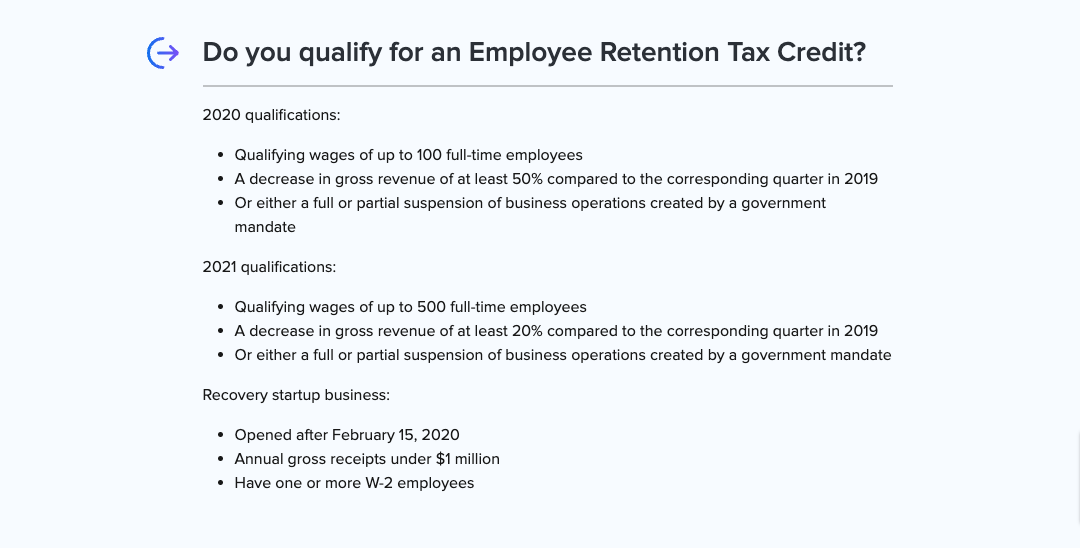Small businesses can still apply for the Employee Retention Tax Credit—here's what you need to know

Canva
Small businesses can still apply for the Employee Retention Tax Credit—here’s what you need to know
Two women small business owners talking
Did your small business keep employees on your payroll through the pandemic? Congratulations! You may be eligible for a tax credit from the Internal Revenue Service.
The Employee Retention Tax Credit, referred to as the ERTC or the ERC, was first launched in the early days of the COVID-19 pandemic as part of the CARES Act relief package. It was intended as an extra incentive for smaller businesses to retain their employees, although the Payment Protection Program widely overshadowed it.
The ERC is still available retroactively for both 2020 and 2021. Lendio breaks down the ERC to help you determine whether you qualify for it.
Key points:
- The ERC is a pandemic relief tax credit that gives qualifying businesses up to $26,000 per W-2 employee
- Even though it is termed a tax credit, you can get paid in excess of what you’ve paid in taxes
- Businesses that received PPP loans are eligible for the ERC too
- Businesses have until April 2024 to amend their 2020 tax filing and until April 2025 to amend their 2021 filing to apply for the ERC
What is the Employee Retention Credit?
The Employee Retention Credit is a refundable tax credit intended to encourage businesses to continue to pay employees throughout government shutdowns during the COVID-19 pandemic.
CARES Act – 2020: The Employee Retention Credit was first introduced as part of the Coronavirus, Aid, Relief, and Economic Security Act (CARES Act) in 2020. The act permitted qualifying businesses to claim 50% of qualifying wages up to $10,000 per employee paid from March 13 through Dec. 31.
Consolidated Appropriations Act – 2021: The Employee Retention Credit was updated in 2021 to allow qualifying employers to claim 70% of qualifying wages up to $10,000 per quarter in 2021.
American Rescue Plan Act – 2021: This act added recovery startup businesses who started their business on or after Feb. 15, 2020, as eligible businesses if their annual gross receipts didn’t exceed $1 million in 2020 or 2021 and they had more than one or more W-2 employees excluding family members.
Infrastructure Investment And Jobs Act – 2021: This act terminated the ERC credit for the 4th quarter of 2021 except for recovery startup businesses.
![]()

Lendio
How the ERC works
chart showing how much money a small business gets from the ERC
The Employee Retention Credit is a refundable tax credit for qualifying employee wages. The credit is based on payroll taxes rather than income taxes, so you can still receive the credit even if you paid no income taxes in 2020 or 2021.
The best part is because it is refundable, it’s possible to receive money back beyond what you originally paid in payroll taxes. So if you qualify for $50,000 under the ERC, but only paid $10,000 in payroll taxes, you would still receive the full $50,000 refund from the IRS. Bear in mind there is a small non-refundable portion of the ERC that is limited to the amount you actually paid in employee Social Security and Medicare taxes.
How much money will my small business get from the ERC?
For tax year 2020, eligible small businesses can claim 50% of the first $10,000 in wages per employee through the Employee Retention Credit. This adds up to a maximum of $5,000 per worker, and you can apply for this credit now in 2023.
For the first 3 quarters of 2021, eligible small businesses can claim up to 70% of the first $10,000 in wages per quarter for each employee. This amounts to $21,000 per employee.
In total, a small business could potentially receive $26,000 in credits per employee kept employed through 2020 and 2021. Keep in mind that the IRS defines certain health care expenses as part of an employee’s wages.
Is my small business eligible for the ERC?
While businesses of all sizes can benefit from ERC, the program favors small businesses over larger employers. You can find out here if you qualify for the ERC and the fastest way to claim your credit.
Number of full-time employees
For tax year 2020, a small business is defined as a business that averaged 100 or fewer full-time monthly employees in 2019. For tax year 2021, the definition is expanded to include businesses that averaged 500 or fewer full-time monthly employees in 2019.
Larger employers can claim the ERC but only for wages and some healthcare costs paid to employees who did not work.
For small businesses, you can claim the credit for all employees whether they worked or not.
Government-mandated full or partial suspension
Now, to be eligible for the ERC, your business must have been impacted by either a government-mandated lockdown or a decrease in revenue.
If your business was impacted by a full or partial suspension of operations because of a government COVID-19 order during any quarter, you can qualify. This includes restrictions on hours or capacity. This area of eligibility criteria is complex, so work with a vendor who is familiar with government orders, their impact, and the timeframe they were enacted.
A few examples of a qualifying business include:
- A business that was ordered to fully suspend operations
- An essential business that remained open but had government-mandated limited hours or capacity, such as a restaurant that could use fewer tables.
- A business whose suppliers experienced shutdowns and were unable to make deliveries
- A business that had to shut down a portion of the business due to government mandates
Significant decline in gross receipts
Your business can also qualify if it experienced a “significant decline” in gross receipts as defined by the IRS. For tax year 2020, a significant decline means gross receipts for a quarter are less than 50% compared to the same period in 2019. For the first 3 quarters in 2021, it means quarterly gross receipts are less than 80% compared to the same period in 2019.
For the first 3 quarters of 2021, if your business did not see a 20% decline in gross receipts compared to 2019, businesses can also elect to use the immediately preceding quarter for comparison. This means that if a business’s Q2 of 2021 isn’t eligible compared to Q2 of 2019, it can instead use Q1 of 2021 and compare it to Q1 of 2019 to meet eligibility.
Recovery startup business
If you have a newer business, the ERC was amended in 2021 by The American Rescue Plan to even let you gain access. So-called “recovery startup businesses” can apply for the credit for Q3 and Q4 of 2021. Recovery startup businesses are defined as ones that opened after February 15, 2020, and have annual gross receipts under $1 million. As long as you meet these two criteria and have one or more W2 employees, you don’t have to meet the other eligibility requirements. The maximum a recovery startup business can receive is $50,000 in ERC per quarter.

Lendio
How to apply for the Employee Retention Credit
A graphic explaining the qualifications for the Employee Retention Credit
First, before filling out any forms, consult your accountant or tax professional. They will help guide your business through this process. Because eligibility might be tricky to sus out, especially if you applied for PPP loan forgiveness, a tax professional who specializes in ERC will be well worth the cost.
Since you will need to claim the ERC retroactively, you can file Form 941-X to amend your previous return.
What is considered qualified wages?
Qualified wages vary based on the year and size of your business.
In the following situations, all wages qualify regardless of whether employees worked or not:
- In 2020: 100 or fewer full-time employees
- In 2021: Fewer than 500 full-time employees
If you had more than 100 full-time employees in 2020 or more than 500 full-time employees in 2021, qualifying wages are wages paid to an employee while they were unable to work due to suspended operations or a substantial decline in revenue.
A full-time employee is defined as any employee who worked more than 30 hours/week on average. In general, the wages of the owner or family members of the company owner do not qualify.
Cash tips greater than $20/month would be included as qualified wages.
Can I still apply for the ERC during the moratorium?
Yes, small businesses can still apply for the ERC during the moratorium announced by the IRS.
On September 14, 2023, the IRS announced a pause on processing new Employee Retention Credit claims. The moratorium will last at least through the end of 2023.
What this means:
- Applications received prior to the moratorium will continue to be processed
- Processing times will be longer — potentially expanding from a 90-day turnaround to 180 days or more
- Payouts for previously filed claims will continue through the moratorium
- The IRS will begin a more scrutinous compliance review period to protect businesses from bad claims
- New claims can still be filed, but they will not be reviewed until after January 1, 2024
This story was produced by Lendio and reviewed and distributed by Stacker Media.